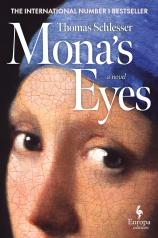Reading Group Guide
Discussion Questions
Mona's Eyes

1. Throughout the novel, Mona relies on her friends, Jade and Lili, as a source of joy and support, in everything from dealing with bullies in the school yard to a game of truth or dare. How do you see the three friends navigate different experiences of childhood together? What do they learn from one another, and how do they mature over the course of the book?
2. Each chapter begins with a scene from Mona’s life at school, with her family, or with Dr. Van Orst before shifting to a visit to a museum with Henry. How does this split narrative change your understanding of the characters, compared to if you only learned Mona’s story from one side or the other? How do you see Mona apply what she learns from Henry and the artists to her daily life, and vice versa?
3. “Believe it or not, there’s a poet whose journey is remarkably similar to Van Gogh’s. He’s called Arthur Rimbaud... Rimbaud and Van Gogh never met. But in his most famous work, the poet unwittingly gives us the lesson of this painting” (pg. 272). Henry points out to Mona connections not only between the different artists he shows her, but also connections between art and science, music and literature. Are you convinced by Henry’s argument that all these things are connected? How do you think MONA'S EYES participates in the tradition of interaction between art and literature?
4. Henry teaches Mona about several artists whose disabilities “sublimate” their abilities, from Frida Kahlo to Claude Monet. In what ways does Mona’s impending blindness change how she interacts with the world? How do you think Thomas Schlesser suggests that disability can also be ability?
5. Mona’s grandfather, Henry, makes promises by swearing on “all that’s beautiful on earth.” He tells Mona that what’s beautiful on earth includes art like that by Goya, and also includes Mona herself. What is your interpretation of Henry’s oath? How does the novel suggest that beauty is something sacred? What do you think of when you think of “all that’s beautiful on earth”?
6. Mona and her father sell Vertunni figurines to a man who uses them to reconstruct scenes from his memories. The figurines initially belonged to Mona’s grandmother, who told stories with them to exercise her memory. What role do the figurines play in preserving memory in the novel? What are the similarities or differences between the Vertunnis and the art Mona’s grandfather shows her? How do you think art can be a tool to capture memory or imagine a future?
7. What did you learn about art from this novel? Which was your favorite artwork or artist to read about? Why?
8. Mona keeps various secrets throughout the novel: from her parents, her friends and even her grandfather. Do you think she’s justified in keeping these secrets? What roles do trust and secrecy play in the novel?
9. Colette’s death is a major source of grief for many characters in the novel, and Henry and Camille both struggle to talk about Colette. How do characters in the novel deal with grief in productive or unproductive ways? How do you think Mona grieves for a grandmother she hardly remembers? In what ways is the novel a tribute to the memory of Colette?
10. “One must go to the Louvre via nature, and return to nature via the Louvre” (pg. 438). Henry shares this quote from Cézanne with Mona towards the end of the novel. How do you interpret this quote? How do Henry and Mona traverse both nature and art across the 52 weeks?
11. Did you find you wanted to look at the artworks mentioned in the novel as you read? Or did you prefer to have a pure reading experience? If the latter, how well were the artworks conveyed to you through Schlesser’s writing? Is there a sense in which a listener of the audiobook or a reader of the book can really experience the artwork described? Or is the old maxim true that “writing about art is like dancing about architecture”?
12. Henry develops a strict ritual for his visits to the museum with Mona: one artwork per visit, one visit per week. As a parent, grandparent, older family member or caretaker, have you ever attempted something programmatic like Henry and Mona’s museum visits with your children, grandchildren or other young people in your life? How did it go? What made it work/not work? Why did you do it?
Mona's Eyes
- Publication Date: August 26, 2025
- Genres: Fiction
- Hardcover: 432 pages
- Publisher: Europa Editions
- ISBN-10: N/A
- ISBN-13: 9798889661115






